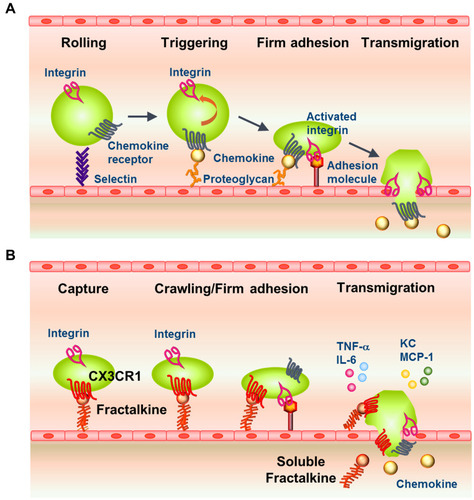Figures & data
Figure 1 Classical and Fractalkine–CX3CR1-Mediated Pathways of Leukocyte Recruitment to Inflamed Tissue. (A) Model of the classical pathway for leukocyte extravasation into sites of inflammation via an adhesion and transmigration cascade. Leukocytes adhere to the endothelial layer through selectins (tethering and rolling), which is followed by engagement of chemokine receptors and integrin activation (firm adhesion), and transmigration into the underlying tissue. (B) Model of the involvement of fractalkine-mediated pathways in the adhesion and transmigration of CX3CR1high leukocytes from the circulation into inflamed tissue. Fractalkine–CX3CR1 engagement enhances the transient capture and attachment of leukocytes to endothelial cells, which is followed by crawling/firm adhesion (activation of integrins by chemokines), production of inflammatory cytokines, and transmigration through the endothelial layer to the sites of inflammation.

Figure 2 Results of a Phase 2 Clinical Trial of E6011, a Humanized Anti- FKN mAb, in Subjects with RA (NCT02960438). (A) ACR20 response rate of the full cohort at Week 24 (NRI). (B) ACR20 response rate at Week 24 in the patient subset with a high percentage of CD16+ monocytes at baseline. Subjects were divided into high and low groups using the median percentage of CD16+ monocytes at baseline (10.35%). Reproduced from ACR/ARP Annu Meet, A Phase 2 Study of E6011, an Anti-Fractalkine Monoclonal Antibody, in Patients with Rheumatoid Arthritis Inadequately Responding to Biologics, Tanaka T, Takeuchi T, Yamanaka H, et al. 9(Supplement 70):1-3553, copyright 2018, with permission from BMJ Publishing Group Ltd.Citation45

Table 1 Cytokine-Targeting Therapies in Development for RA
